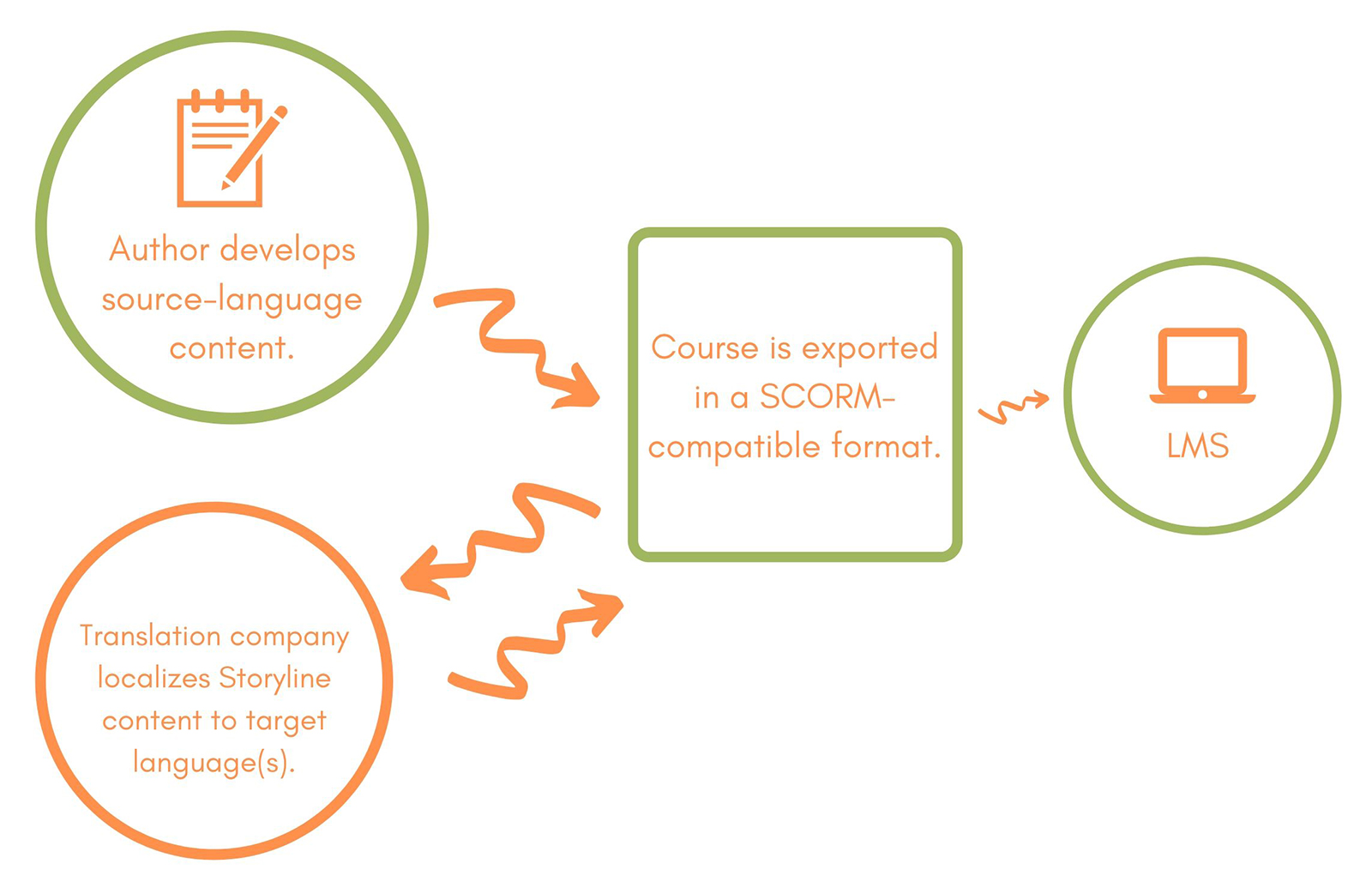Companies around the world over rely on specialized courses and instruction to train their global workforce. There’s a long list of benefits that come with employee training: improved performance, boosted morale and job satisfaction, consistency across teams, and increased productivity, to name a few.
With the globalization of companies, the way training is delivered has changed. What used to take place in-person now takes place online using computers and mobile devices. Self-paced eLearning has become a method of choice to train employees and build important skills within a global workforce. It is affordable and easily shareable, making it one of the most popular ways to teach critical knowledge and skills to employees.
What is Storyline and what does it do?
Articulate Storyline is one of the leading eLearning authoring applications. Storyline allows companies and leadership teams to create their own cutting-edge interactive courses without needing extensive computer, coding, or graphic design knowledge.
How can your organization benefit from Storyline translation?
In most cases, English is the primary language of Storyline course development. However, English may not be the first language of everyone within your organization. When a course is only offered in one language, it excludes a number of employees or customers that could benefit from the curriculum.
Storyline translation and localization allows your eLearning courses to reach a larger audience. Everyone, no matter the language spoken, will be able to accurately synthesize the material being presented. This allows everyone across your organization to receive the same level of education and exposure to tools. When all of your employees are on the same page, you set your company up for success in a global market.
Translating into a person’s mother tongue ensures that those taking the course understand the material as it was intended. Even if individuals are proficient in the original course language, comprehension and information retention rates improve when someone receives information in the language they are most comfortable with. Localization makes the final product feel as if it were created for that specific target market rather than just being translated as an afterthought.
How is a Storyline course translated?
Translating a course created with Storyline is more involved and complex than simply rewriting the text in the target language or adding captions. There are more moving parts involved. A proper translation will also include localization. With localization, all of the course’s multimedia and interactive properties are taken into consideration and will be translated, correctly formatted, and integrated into the course.
This includes:
- On-screen content and subtitles: All on-screen text will be translated. One issue that commonly occurs is the expansion of text with a translated language. To combat this, an eLearning engineering specialist will reformat the screen so that it appears as originally intended.
- Audio overlays: If audio narration is present in the course, it can be translated and re-recorded in the target language. Translated subtitles and audio will need to be correctly synced with the audio and graphics in a way that makes sense to the user.
- Videos: Similar to audio overlays, voice-over recording can be performed on video content, as well as changes to any visual language presented. Videos can be embedded within the course to aid the learner.
- Graphics: images and graphics within your course may contain text or symbols that need to be translated. The localization of graphics is commonly performed by a multilingual desktop publishing specialist with visual editing experience. Even factors such as colors should be carefully considered, as meaning can vary from culture to culture.
- Navigation controls: Aside from the actual content within the course, navigational controls and action buttons should be translated for ease of use. This includes operations like PREVIOUS, NEXT, CONTINUE, etc.
- Interactive quizzes or games: Quiz, assessment, and game content should be translated into the target language, as well as any instructions or controls.
- Mouse cursor movement captures: Within a course, users may be able to move the cursor to reveal items or actions that the narrator is explaining. These descriptions should be localized in the program.
- Additional documents and resources: Oftentimes, additional documentation and resources are linked to the courses. This may come in the form of tip sheets, checklists, job aids, and more. It is important that translations are consistent across these documents so that all learners can be equipped with the appropriate tools.
SCORM Online Learning Translations
eLearning courses are often published as Shareable Content Object Reference Model (SCORM) content. More than just a funny word, SCORM is the set of technical standards that allow eLearning courses to be played across different Learning Management Systems (LMS’). It gives companies the ability to share their content on different systems without headaches that come from coding that isn’t compatible.

Think of it this way: if you own a DVD, you don’t have to worry about the brand of DVD player that you’re using. Any brand DVD player will play any film since DVDs are made using industry-wide standards. Similarly, a course written with the SCORM standard can be used in any SCORM-conformant LMS.
A company with eLearning localization experience will know how to match the publishing of the English SCORM package with the target language. SCORM-compatible translation solutions ensure that everyone can utilize your web course seamlessly and easily, regardless of language or the Learning Management System used.
How can a translation company help?
Translation companies can help in several ways. To start, professional translation companies provide the best multilingual talent to ensure both the technical accuracy and linguistic quality of the translated material. Additionally, translation companies can also convey the cultural nuances needed to ensure that your content effectively resonates with the intended audience. In addition to the actual language component, experts can determine whether or not visuals, symbols, and gestures are culturally appropriate.
The key, however, is finding a translation company that does more than just produce accurate translations. The company should be able to edit, proofread, format, and integrate the translated content back into the Storyline source file, as well as execute final course publishing and Quality Assurance. If a voiceover is needed, the company should be capable of producing professional-grade studio recordings and know how to insert and sync the audio within the courses.
A turnkey process will leave your team with no additional work. There will be no need to upload files or work to perfectly match the source language course— everything will be ready to go and use upon delivery. Quality Assurance practices will ensure that your product is reviewed by a native speaker who will engage with the content just as your employees would. An experienced translation company will also work with you to develop customized solutions that match your specific needs and requests.
Adapting to Changing Software and Trends
As with most software applications, Storyline is ever-changing with periodic version releases. Because of this, it’s imperative that your translation partner has the ability to adapt quickly. Storyline currently has five versions: the original Storyline 1, Storyline 2, Storyline 3, Storyline 360, and Articulate Rise. Each version gives authors more control and has more features than the previous versions. While more options are always good for those creating and taking the course, it can involve more complex work for those tasked with translating them.
These changes follow important trends in the eLearning industry. For example, due to the rising popularity of mobile learning, the newest versions of Storyline have a responsive design for smartphones and tablets. It’s important that translation companies be aware of changes like this to ensure that courses are correctly formatted across all languages, no matter what device is being used.
Experts are predicting growth in the use of video and experiential learning simulations. Translation of components like these are best done by the experts, as professional quality dubbing and localization are not as straightforward as you may think. Similarly, as the role of personalized learning experiences begins to grow, the importance of translation and localization expands. eLearning translation professionals can tailor fonts, sizes, and other on-screen elements to specific audiences.
Thanks to technology and the services of professional translation companies, your organization’s training programs aren’t limited geographically. Articulate Storyline courses can provide your employees with the skills and knowledge they need to succeed within your organization. By translating and localizing these courses into the languages of your target audience, you not only help those individuals grow professionally, you also help the entire organization achieve success on a global scale.

